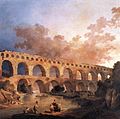Series
The paintings were made using oil on canvas. The subjects are ancient Roman ruins in Provence in southern France. The structures depicted are the interior of the Temple of Diana in Nîmes, the Triumphal Arch and Roman Theatre in Orange (combined in an imaginary perspective), the Maison Carrée, amphitheater and Tour Magne in Nîmes (also from an imaginary perspective), and the Pont du Gard over the Gardon river.
- Interior of the Temple of Diana in Nîmes (Intérieur du Temple de Diane à Nîmes), 242 × 242 cm
- The Arc de Triomphe and the Theater in Orange (L'Arc de triomphe et le Théâtre d'Orange), 242 × 242 cm
- The Maison Carrée, the Amphitheater, and the Tour Magne in Nîmes (La Maison Carrée, les Arènes et la Tour Magne à Nîmes), 243 × 244 cm
- The Pont du Gard (Le Pont du Gard), 242 × 242 cm




